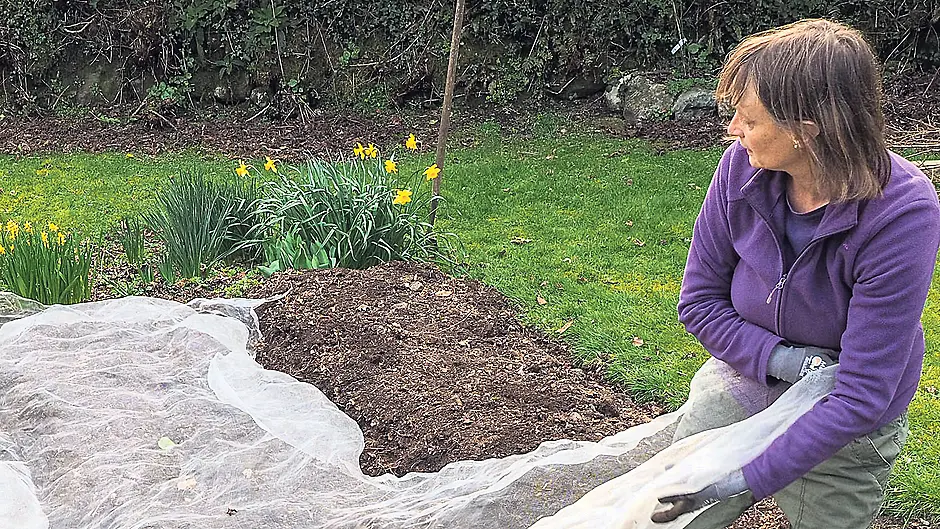BY JOYCE RUSSELL
THERE lots of jobs to do in the garden now and it makes sense to use any fine day that you can. The planting season is kicking off and it’s good to get some early crops in the ground. Dig over beds and add some feed if you haven’t already. There’s a lot to go into the ground in the next few weeks so make sure you are ready and raring to go with all the spring planting.
Choose a fine day and a bit of sun will make the work seem easy. There’s beautiful birdsong as well as fresh green leaves and colour from spring bulbs to lift a gardener’s spirits.
Potatoes
Early and second early varieties go into the ground around now. They may not have very big shoots, but still get them planted if you can. There are other jobs piling up in the weeks to come, so each one you tick off the list is a bonus. Those small shoots will grow fast and first leaves will poke through the soil in a month or so.
It’s a good idea to cover newly planted rows with crop cover until risk of frost is passed. A light mesh material that lets rain and light through is perfect. Be sure to weight down the edges so the cover stays in place. Even if leaves are a little burned by a very hard frost, they seldom suffer serious damage and grow well when the covers are removed.
Onions
Onion sets look like tiny onions. Push them in the ground and most will grow. You can help them make bigger bulbs by allowing 15cm between sets and 30cm between rows.
Dig in some compost or well-rotted manure to make sure the soil is enriched with enough nutrients. A bit of lime is useful on acid soil or scatter some wood ash between the rows.
You may need to cover the bed with some netting if birds start to pull up the new planted onions – perhaps they mistake the brown tops for earthworms. They will stop doing this, and you can uncover the bed, when green shoots start to grow.
Keep soil damp and water well in dry weather. This is particularly important when bulbs are swelling.
Root crops
Wait until April to sow carrots outdoors or until the soil doesn’t feel cold when you place a hand flat upon it. You can sow beetroot in drills in a dug and raked bed and you can still sow parsnips to make decent sized roots for winter use.
All of these benefit from a covering with horticultural fleece or fine crop cover – this protects against frost and reduces some pest problems.Other things to try
Garlic: Autumn sown garlic should be growing well and there should be a few strong green leaves on each plant. You can plant spring varieties now – simply break open the bulb and plant individual cloves – although these don’t usually make as big bulbs as autumn sown ones.
Cucumbers: I sow mine around the middle of March. Keep them growing between 15C and 25C if you can and they will be ready to plant in the greenhouse in May.
Courgettes: Sow three seeds in individual pots and keep them at 15C. These early plants can produce early courgettes in late May and, by June, fruit will be popping off the plants. Early plants do best if grown in a polytunnel or greenhouse, but they can do very well outdoors if given some covering against wind and cold until the weather settles.
Keep harvesting
Spring cabbage, spinach, salad leaves, leeks and chard will all put on a spring growth spurt. This can soon lead to plants bolting and attempting to flower. Keep picking and using what you can before leaves turn too bitter. At some point you will have to lift the lot, but you should get a few weeks of glut before that point is reached.
Spinach freezes well – wash and steam leaves for a couple of minutes before running under cold water. Chop and squeeze into balls with your hands before flash freezing on trays. Balls can go into bags once frozen.
Sprouting broccoli is starting to grow shoots. Before they come ready, take a look at your kale plants. These produce shoots too and if you keep picking them, then more will grow. Kale shoots are one of the tastiest treats at this time of year. You might never see them in a shop, but they are a delicious bonus for the gardener. Fry them in a little olive oil or steam them lightly with a squeeze of lemon juice. Don’t remove plants until you really can’t stop them from flowering and the last shoots are too woody to use.






